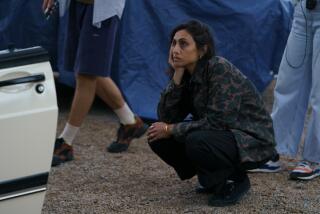Emma Donoghue wrote her terrifying pandemic novel before COVID, thanks very much
- Share via
If you buy books linked on our site, The Times may earn a commission from Bookshop.org, whose fees support independent bookstores.
The hospital is overwhelmed, a lone nurse in charge of a ward full of pregnant women in the middle of a health crisis. The hallways are clotted with the sick and the dying. The exhausted staff try to protect themselves from a new disease no one fully understands.
“I’ve actually had people say to me: ‘Is it not a bit mercenary to write a novel about a flu and bring it out this fast?’” said the novelist Emma Donoghue, laughing. “I say to them, ‘Do you think I can write a novel and publish it in four months?’”
The novel in question is “The Pull of the Stars,” set over a few fevered days in a Dublin hospital in 1918. During the centenary of the worst flu pandemic in modern times, Donoghue started digging into its history and became inspired by a nugget of information — that women in late pregnancy were the most vulnerable to the disease.
“I love researching for fictional storylines because you could just look for the interesting stuff. It’s like a seagull poking through a garbage can,” Donoghue said cheerfully, her Irish accent worn soft by two decades of living in Canada. During our Zoom talk, she pulled a 1910 obstetrics book off the shelf and held its graphic illustrations of difficult births up to the camera to demonstrate what went into her story.
It doesn’t feel, though, like a historical novel at all. “The Pull of the Stars” moves with the quickness of a thriller, but instead of spies and helicopters there’s nurse Julia Power in an ad hoc maternity ward.
That sensation of hurtling through the story seems to reflect Donoghue’s own creative metabolism. She has a hard time remembering how many books she’s published since her 2010 novel “Room” became an international bestseller. (Three novels, two children’s books and a short-story collection.) “The new books are always coming down the highway at me,” she said. “I’m focused on ‘Oh, God, which one will I write next?’”
Over the last three months, 17 writers provided diaries to the Times of their days in isolation, followed by weeks of protest. This is their story.
The hospital in the novel is desperately understaffed — in addition to the flu, the Great War is on — and Julia is suddenly given responsibility for the women in her care. Officially, she has little authority; she can’t even give the patients aspirin (though, this being Ireland in 1918, whiskey is permitted). Unofficially, it’s all on her.
“So many rules I was getting used to breaking,” she thinks, in a passage that has one foot in its fictional moment and the other in today’s worsening reality. “Only for the duration, of course, for the foreseeable future, as the posters said. Though I was having trouble foreseeing any future. How would we ever get back to normal after the pandemic?”
The eerie resonances with the moment were not part of Donoghue’s original plan; the book was scheduled for 2021. But when publisher Little, Brown and Company got the manuscript in March, it suggested, reasonably and cannily, that it might be better to rush the book to publication.
The course of the pandemic in “The Pull of the Stars” closely mirrors our own — illuminating in particular the lives of healthcare workers under tremendous strain.“I was lucky enough to have an emergency room doctor as my copy editor, a dream situation,” Donoghue said. “When she got to the bit in the book where Julia almost steps in a pothole and thinks, ‘Well, if I’d broken my leg, I’d have to take some time off,’ my copy editor underlined it and was like, ‘Yes, yes, that! I’ve had that feeling.’ I was trying to capture not just the courage of healthcare workers but their stamina.”
At night Julia heads home through the desolate city. “All the Dubliners who could had escaped to the suburbs, leaving the rest to live like squatters in the capital’s rotting heart.” Luckily, she’s brought an inexperienced helper, Bridie, whose enthusiasm, as much as her and willingness to mop up bodily fluids, helps the frantic Julia get through each day.
She also gets help from a doctor, Kathleen Lynn, a radical female physician who actually existed. “When I was reading up on 1918 in Ireland, Kathleen Lynn was so useful for my story,” Donoghue said. One draft featured a fictional version, but this one is the real thing. “She’s unique, so I might as well give her the props.” Lynn discusses things Julia hasn’t had time to think about — poverty, feminism, politics.
“I thought it was interesting to raise the question,” said Donoghue. “At what point [is it] important to take a stand politically rather than just burying yourself in what you think is your task in life?”
Emily St. John Mandel, Susan Orlean, T.C Boyle, Marlon James and others share apocalypse reading picks.
Perhaps that tension — between private, solitary work and a sense of public responsibility — goes back to the whirlwind success of “Room.” “When ‘Room’ happened, I remember thinking, ‘OK, I’m not going to let this mess up my relationship to my own writing. I’ve always been a successful writer on my own terms. I absolutely love writing, so I’m not letting this wreck it.’ And then the same thing happened with the film.”
The movie of “Room” came out in 2015 and was nominated for four Academy Awards, including original screenplay for Donoghue, a first-time screenwriter. (It won one: Brie Larson for lead actress.) “That was such a mad year,” she said. Although they were living in France, Donoghue and her partner were swept up into the Hollywood awards circuit. “Chris and I would fly from Nice to L.A. and arrive so jet lagged and bewildered and go to parties, just stunned by it all,” she said. “It’s like briefly joining the aristocracy. Like some Dickensian novel where somebody is suddenly hoisted up to being presented at court.”
“Room” is told partly from the point of view of a little boy who’s trapped with his mother, unaware of his confinement, and partly narrated from the outside. Donoghue modestly credits director Lenny Abrahamson’s wise choices, but her ability to transform her own deeply internal novel into a film that tells it so differently is plainly remarkable.
In “The Pull of the Stars,” Donoghue has pulled off another feat: She wrote a book about a 100-year-old flu that feels completely current, down to the same frustrations and tensions and hopes and dangers. And she did it without even knowing just how relevant it would be — how well and frighteningly her own reimagining of a historical catastrophe would square with our actual living experience of its modern sequel.
Kellogg is a former books editor for The Times.
More to Read
Sign up for our Book Club newsletter
Get the latest news, events and more from the Los Angeles Times Book Club, and help us get L.A. reading and talking.
You may occasionally receive promotional content from the Los Angeles Times.










